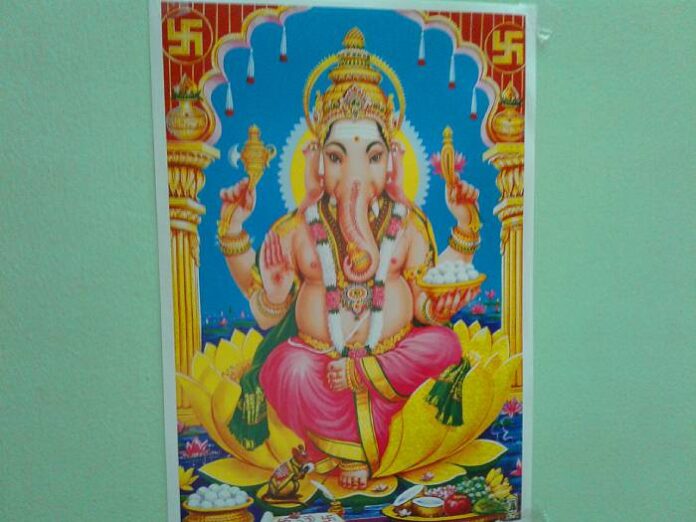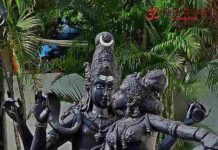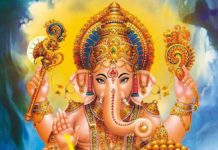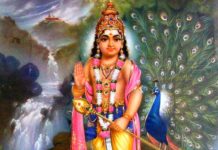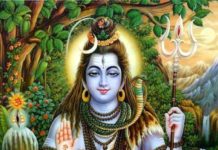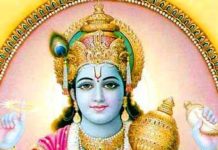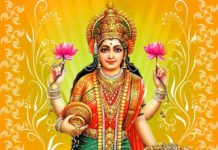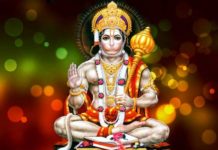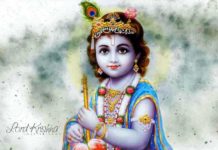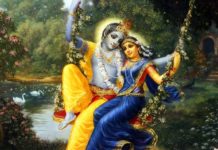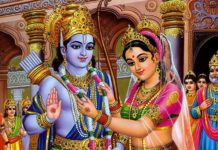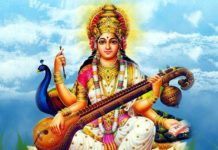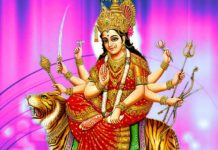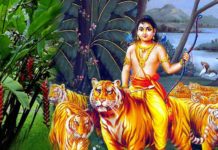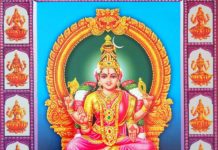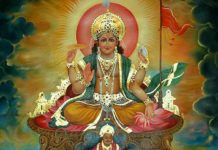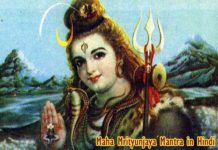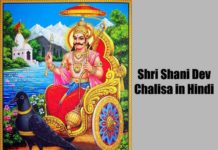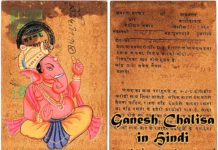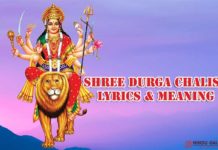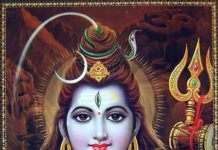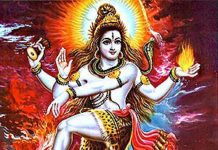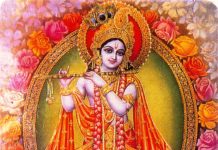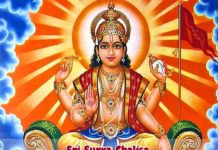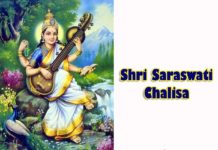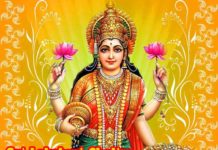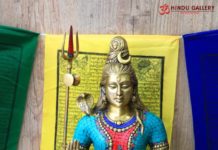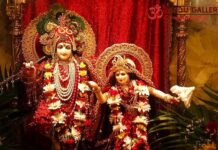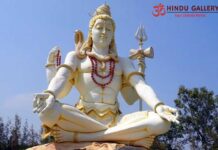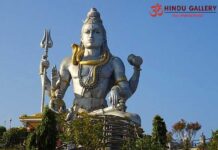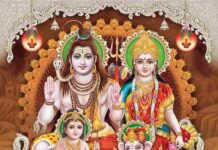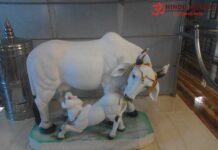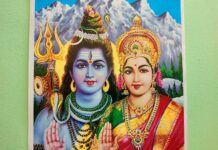Sankashti Chathurthi Vrat is ascribed to Bhagwan Sri Ganesha. The Vrat is also known as Sankata Hara Chathurthi.
Sankashti Chathurthi Vrat is observed on the fourth day from the full moon day. It is Krishna Paksha Chathurthi. This is different from Sri Vinaya Chathurthi which is observed on the Shukla Paksha Chathurthi.
Sankashti Chathurthi Vrat is observed for twelve days in a year, once a month. For the year with adhika maasa (excess month due to the movement of planets), thirteen vrats are observed. This adhika maasa Sankashti Chathurthi occurs once in four years.
Sri Vinayaka – Origin
There are innumerable versions on the origination of Sri Vinayaka.
Bhagwan Shiva and Goddess Parvathi
As per Sri Vamana Puran, Bhagwan Shiva and Goddess Parvathi were living in a palace built by Sri Visvakarma, the celestial architect. Meanwhile, Indra, the head of Devas was worried that if Bhagwan Shiva and Parvathi Devi begot a male child, his position would be dangerous.
Bhagwan Shiva teasing
One day, Sri Maheshwara teasingly called Sri Uma Devi as “Kaali”. Sri Uma got upset that She was called thus because of Her dark color.
Sri Uma Devi penance
So, She did penance on Sri Brahma. When He asked Her the purpose of Her tapas, She said that She wanted to be fair complexioned. Sri Brahma consented.
Katyayani and Gowri
Sri Brahma had removed Her dark color and made it into a Goddess named Sri Katyayani. The fair colored Uma Devi was called as Sri Gowri.
Indra’s tactics
Indra tried to adopt various tactics to prevent the begetting of a male child by Sri Eshwara and Sri Eshwari. Sri Parvathi was furious with this.
(The story so far is described thus in Sri Vamana Puran).
Sri Gowri’s deed
As per the legend and the beliefs, Sri Gowri had created a child form from Her bath powder and gave the child life. She had asked the child to keep guard when She was taking bath.
The Child’s bravery
Bhagwan Shiva came back home. Not knowing Him, the child refused to allow Him. Bhagwan Shiva was furious. He told His Ganas that the child needs some lessons in manners. On cue from Bhagwan Shiva, the Ganas started fighting with the child.
As Bhagwan Ganesha was made by Goddess Parvathi who is the embodiment of Shakthi, He was very powerful. The Ganas were not able to fight with Him after a stage. He stated emphatically that nobody can enter the place when His mother is bathing.
Narada’s appeasement
The celestial Sage Narada sensed the trouble. He took the Saptha Rishis with him to appease the child to stop the fight. Even that team failed.
Indra’s efforts
Then Indra, the King of Devas took the fight upon himself. He continued the war. But even his army had to beat the retreat as the Kid was extremely powerful.
Bhagwan Shiva’s act
The situation had come to the extent where Bhagwan Shiva had to intervene in the fight. He was enraged at the boy and severed His head.
Sri Parvathi’s outrage
Sri Parvathi Devi emerged after Her bath. She was furious that Her child was killed. Her anger was severe. She wanted to destroy the then existing universe and replace it with a new universe.
The Devas were anguished. They fell at Her feet and begged for mercy. Bhagwan Shiva also promised Her that Her son shall live again.
Bhagwan Shiva giving life
Bhagwan Shiva had come across the head of the baby elephant which had died. He fixed the elephant head to the child and the boy became live again.
There is another legend whereby Bhagwan Shiva was said to affix the head of Gajasur whom He had destroyed.
Sri Parvathi Devi gave life to the child first. Bhagwan Shiva gave life to the child for the second time. By giving life, Bhagwan Shiva and Sri Parvathi had become the parents of Bhagwan Ganesha.
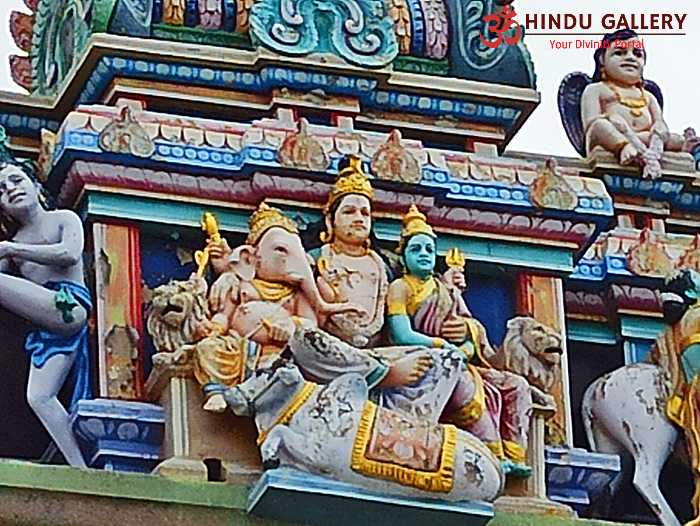
Bhagwan Shiva’s blessings
As per Sri Vamana Puran, Bhagwan Shiva had named the Child as Vinayak as He was born with the support of only Mother and no Nayak was involved. Sri Vinayak was also named as Ganapathi, which means “the leader of the Ganas”.
It is also believed that only on the Krishna Paksha Chathurthi day, Bhagwan Shiva had declared that Bhagwan Ganesh shall be the prime God and as superior as Shiva, Parvathi, Vishnu and Lakshmi. Hence this day is celebrated as Sankashti Chathurthi or Sankata Hara Chathurthi.
Worshipping of Sri Vinayaka
Sri Bhavishya Puran states about worshipping Sri Vinayaka. There was a time when people on the earth were blessed with all the good things. They had become complacent.
As everything came to them easily, they did not give reverence and importance to God. This had irked Sri Brahma.
So, Sri Brahma made the situation worse for them. People started to have troubles in their lives. They approached Sri Brahma for guidance.
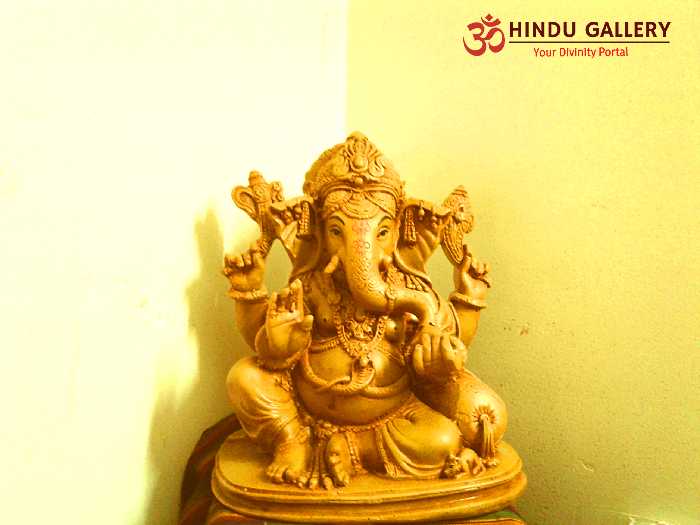
He ordained that they should worship Sri Vinayaka if they wanted to get over the obstacles. From then onwards, people made it a practice to first worship Sri Vinayaka before embarking on any work or deed.
They appreciated the God’s grace for the happenings in their life, which thitherto they had taken for granted.
Sankashti Chathurthi Vrat – Legend
There are a few legends pertaining to the significance of Sri Sankashti Chathurthi. The legend is said to be mentioned in Sri Vinayaka Puran.
King Shursen
Once, there was Kingdom named Sahasrapuri. It was ruled by the King Shursen. He was a very good ruler. His wife was Susheela (a) Punyaseela. Both the King and the Queen were pious.
One day, the King was holding a meeting with his ministers at his palace. They heard a deafening sound. The King sent his men to investigate. He too was curious at the sound. So, he mounted on his horse and went to check the issue.
Devalok Viman
Shursen had spotted a huge peculiar vehicle which was on the field. He went there with his men. The vehicle was of the form which was not available on earth. Nearing the spot, he realized that it was the viman (flight) from the Devalok. He also saw Lord Indra sitting there in the viman.
Lord Indra
On seeing Lord Indra, Shrusen saluted and greeted him. He also asked him what he can do for his comfort. He even invited him to the palace.
Indra said “I cannot come to the palace. I have to leave now soon. Somedays back, Sage Narada came to my place. He was describing his wandering. He told us about Sage Brushundi.
The Sage is living in Dandakavan. He did penance on Sri Vinayak. He is the great sage. People with such greatness are born only once in a crore year. We wanted to see Brushundi and get his blessings. We were blessed.”
Flight mechanism
Indra further added, “When we were returning, our flight has lost its strength and got grounded.
The mechanism of this flight is that, if an evil person sees this flight flying, it will be grounded. If it has to take off again, it needs to be sanctified. That sanctity is possible only if a person observing Sankata Hara Chathurthi looks at this flight. I have decided to wait until then here only.”
Shursen’s orders
Shursen had immediately ordered his men to search for a person who did Sankashti Chathurthi. He himself was not aware of the Vrat. His men were enquiring everywhere.
Another Flight
The searchers saw another divine flight landing at a distant place. They went near the viman. Some Devas from Vinayak Lok were taking a poor woman aboard the flight.
The King’s men were intrigued. They asked the Vinayak Lok Devas as to why she was taken to Vinayak Lok.
Poor woman
The Devas said “this lady did nothing good in this birth. She used to eat dogs and cats. Her character also is not very good.
In her last birth, she was a princess named Sundari. She married a prince. But she used to seduce others. Her husband Chitran put her under tight security.
She did not like confinement. She wanted to be free. One day, she killed Chitran with sword. The guards saw it and caught her. They brought her before the King.
The king ordered killing of her. She was killed. She got this birth.”
Shrusen’s men were confused. They said, “If she is so bad, how come she is being taken to Vinayak lok now?”
Sankashti Puja
The Devas said, “Wait. We have not yet finished.
Last night, due to poverty, she did not eat anything. Today morning she woke up. Today is Sankashti Chathurthi day.
Some Vinayak Bhakts had finished the Sankashti Puja. They had eaten and threw away the eaten leaf with leftover food.
She picked up the leftovers and was eating. They were chanting ‘Vinayaka’. She too chanted ‘Vinayaka’. That had purified her. Sri Vinayaka asked us to bring her. Hence we have come”.
They were then making arrangements to take off the flight.
Flights take off
The men asked the Devas to help start the Indra Viman as well. The Vinayak Lok Devas said that it was not their job.
The condemned woman was slowly walking towards her flight. On the way, she just looked at the Indra Viman which was at a distance. As soon as she saw it, that Viman also took off.
Thus, the flights from Deva lok and Vinayak lok had taken off.
Sankashti Chathurthi – Significance
“Sankat” means Problems or troubles. “Hara” means removal. Hence Sankata Hara Chathurthi or Sankashti Chathurthi is observed for the removal of all the problems.
The greatness of Sankashti Chathurthi is said to be mentioned in Bhavishya Purana and Narasimha Purana. The significance of Sankashti Chathurthi was said to be narrated by Sri Krishna to Yudishtra.
Each of the twelve or thirteen Shankashti Chathurthi Vrat is observed for a different form of Ganapathi on a different seat (Peeta). Each festival is also ascribed with a different story. If the festival occurs on a Tuesday, it is termed as Angaraka Sankashti Chathurthi.
Chaitra Month
Sri Ganesha’s Name: Vikata Maha Ganapathi
Vrat name: Vikata Sankashti Chathurthi
Peeta: Vinayaka
Vaishaka Month
Sri Ganesha’s Name: Chanakra Raja Eka-danta Ganapathi
Vrat name: Eka-danta Sankashti Chathurthi
Peeta: Sri Chakra
Jyeshta Month
Sri Ganesha’s Name: Krishna Pingala Maha Ganapathi
Vrat name: Krishna Pingala Sankashti Chathurthi
Peeta: Sri Shakthi Ganapathi
Ashadha Month
Sri Ganesha’s Name: Gajanana Ganapathi
Vrat name: Gajanana Sankashti Chathurthi
Peeta: Vishnu
Shravana Month
Sri Ganesha’s Name: Heramba Maha Ganapathi
Vrat name: Heramba Sankashti Chathurthi
Peeta: Ganapathi
Bhadrapada Month
Sri Ganesha’s Name: Vigna Raja Maha Ganapathi
Vrat name: Vigna Raja Sankashti Chathurthi
Peeta: Vigneshwara
Ashweeja Month:
Sri Ganesha’s Name: Vakra-Tunda Maha Ganapathi
Vrat name: Vakra-Tunda Sankashti Chathurthi
Peeta: Bhuvaneshwari
Karthika Month:
Sri Ganesha’s Name: Ganadipa Maha Ganapathi
Vrat name: Ganadipa Sankashti Chathurthi
Peeta: Shiva
Margashira Month:
Sri Ganesha’s Name: Akuratha Maha Ganapathi
Vrat name: Akuratha Sankashti Chathurthi
Peeta: Durga
Pushya Month:
Sri Ganesha’s Name: Lambodara Maha Ganapathi
Vrat name: Lambodara Sankashti Chathurthi
Peeta: Soura
Magha Month:
Sri Ganesha’s Name: Dwajapriya Maha Ganapathi
Vrat name: Dwajapriya Sankashti Chathurthi
Peeta: Samanya Deva
Phalguna Month:
Sri Ganesha’s Name: Balachandra Maha Ganapathi
Vrat name: Balachandra Sankashti Chathurthi
Peeta: Agama
Adhika Month:
Sri Ganesha’s Name: Vibhuvana Palaka Maha Ganapathi
Vrat name: Vibhuvana Palaka Sankashti Chathurthi
Peeta: Doorva Bilva Patra
Sankashti Chathurthi – Rituals
As per legend, the significance of Sankashti Chathurthi was said to be explained by Sri Brahma to Pithurdeva. Accordingly, the best way to commence the observation of Sankashti Chathurthi Vrats in one’s life is narrated by Sri Brahma.
There are 12 to 13 Sankashti Chathurthi Vrats in a year. The first Vrat in a person’s life should be Angaraka Sankashti Chathurthi preferably in the Magha month. The rest of the eleven or twleve vrats are to be observed for every subsequent Sankashti Chathurthi.
Practice
People wake up early in the morning. After bathing, the puja place at home is cleaned. The vigraha or the picture of Sri Ganapathi is decorated with flowers. Lamps and Dhup are lit.
Slokams / Stotrams invoking Sri Ganapathi are recited. The story concerned with the respective Sankashti Chathurthi Vrat is read and recited.
Some people observe fasting for the day. By the evening, special abhishekams and archanas are done at Ganapathi temple.
After having the darshan of Chandra, they partake the prasadam which was offered to God as Neivedyam.
Giving daan of food (Annadanam) to the poor and needy is of utmost importance.
The ardent devotees of Bhagwan Ganesha consider the Sankashti Chathurthi festivals as highly auspicious.
Sankashti Chathurthi Vrats – benefits
It is believed that sincere observation of all the Sankata Hara Chathurthi Vrats shall
-bless progeny;
-alleviate all problems in life;
-bring in prosperity;
-assure no re-birth; and
-result in attainment of salvation in Ganesh Loka.
Stories and Slokas
There are various stories and slokas ascribed to Bhagwan Sri Ganesh. A few of them are provided in the article as linked.
The web-site also covers a few of the Sri Ganesh temples as mentioned below:
Sri Siddhi Vinayak Mandir, Mumbai, Maharashtra
Sri Dagdusheth Halwai Ganapathi Mandir, Pune, Maharashtra
Sri Manakkula Vinayakar Temple, Pondichery
Sri Varasiddhi Vinayaka Mandir, Kanippakkam
Sri Vinayaka Mandir, Anegudde, Karnataka
Jai Ganesha Jai Ganesha Jai Ganesha Paahimaam
Sri Ganesha Sri Ganesha Sri Ganesha Rakshamaam
Goddess Parvathi is referred with the other names such as Sri Uma Devi, Sri Gowri and Sri Eshwari]


